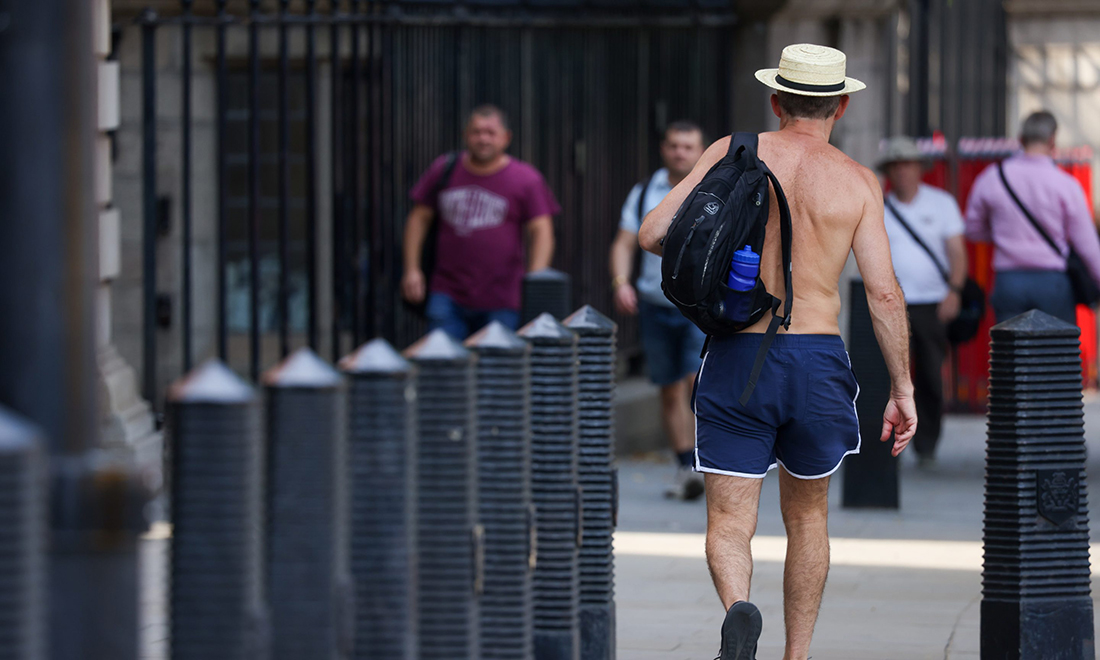
英國正在經(jīng)歷一場史詩級熱浪,,創(chuàng)造了英國歷史上最熱的(暫時(shí)是)一天,,氣溫飆至104.4華氏度(超40.2攝氏度)。英國政府已經(jīng)宣布全國因惡劣天氣進(jìn)入緊急狀態(tài),,英國氣象局發(fā)布了史上第一個(gè)“極端高溫紅色預(yù)警”,,提醒公眾高溫可能導(dǎo)致死亡。
而英國只是最近一個(gè)被這股席卷歐洲的熱浪籠罩的國家,。高溫在西班牙點(diǎn)燃了野火,,給葡萄牙帶來了持續(xù)干旱,熱化了英國機(jī)場的跑道,,進(jìn)一步加劇了倫敦盧頓機(jī)場的航班延誤,。
盡管高溫天氣危害嚴(yán)重,但公共衛(wèi)生官員發(fā)現(xiàn),,高溫預(yù)警并不像其他自然災(zāi)害預(yù)警那樣能引起公眾的共鳴,。
“應(yīng)對高溫天氣的問題在于,不是每個(gè)人都認(rèn)為天氣炎熱不好,,”南加州大學(xué)公共政策和行為科學(xué)教授布魯因說道,。
你怎么看待極端高溫天氣的風(fēng)險(xiǎn),,取決于你是哪里人
布萊因說,在英國這樣長年濕冷的國家,,人們可能會(huì)認(rèn)為暴雨,、暴雪和洪水等極端潮濕寒冷的天氣是“差”天氣,但更可能會(huì)對炎熱的天氣表示歡迎,,因?yàn)榻K于可以從一成不變的陰沉中喘口氣,。
相反,炎熱地區(qū)的人更容易認(rèn)識到高溫的潛在風(fēng)險(xiǎn),。布萊因說:“如果你中過暑,,或者曾因?yàn)楦邷靥鞖庥羞^不好的經(jīng)歷,愿意做好自我防護(hù)的可能性就越高,?!?/p>
極端高溫對公眾健康和經(jīng)濟(jì)都會(huì)造成不利影響。根據(jù)美國疾病控制與預(yù)防中心的數(shù)據(jù),,美國每年死于高溫的人數(shù)比其他任何極端天氣都要多,,包括颶風(fēng)和洪水在內(nèi)。
與此同時(shí),,智庫大西洋理事會(huì)(Atlantic Council)的研究人員估計(jì),,2021年熱浪給美國經(jīng)濟(jì)造成了1000億美元的損失,因?yàn)楦邷貙?dǎo)致停電停工,,超過了同年颶風(fēng)造成的650億美元的經(jīng)濟(jì)損失,。
但高溫給經(jīng)濟(jì)帶來的影響看起來是懶洋洋的,不像時(shí)速100英里的大風(fēng)那樣能制造沖擊畫面,,不會(huì)掀翻屋頂或刮斷電線,,因此沒有經(jīng)歷過高溫的人很難將其視為一種威脅。
2015年,,耶魯大學(xué)的研究人員發(fā)現(xiàn),,生活在美國南部各州的人可能比生活在氣候溫和的北部各州的人更重視高溫的風(fēng)險(xiǎn)。但該研究還表明,,因?yàn)楫?dāng)?shù)氐某W∪丝诓煌?,即使在天氣炎熱的州,對高溫風(fēng)險(xiǎn)的感知也可能因縣而異,。
邊緣群體更有可能認(rèn)為高溫是一種健康威脅
研究人員發(fā)現(xiàn),,與窮人和有色人種相比,富裕的美國白人不太可能把高溫視為健康風(fēng)險(xiǎn),。造成這種差異的原因是,,美國的高溫對貧窮和非白人群體造成了不成比例的傷害,因?yàn)檫@些人無法乘涼、沒有空調(diào)或其他降溫措施的可能性更高,。
此外,,弱勢群體暴露在熱浪中工作的可能性更高,這意味著他們因?yàn)楦邷靥鞖鈹_動(dòng)經(jīng)濟(jì)生活而遭受經(jīng)濟(jì)損失的可能性也更高,。大西洋理事會(huì)的數(shù)據(jù)顯示,,美國黑人和西班牙裔居民“比白人多(損失)18%的生產(chǎn)力……因?yàn)樗麄兩钤诟邷氐貐^(qū)的比例更高?!?/p>
公衛(wèi)專家稱應(yīng)改變極端高溫預(yù)警體系
最不習(xí)慣應(yīng)對極端高溫的人最不可能認(rèn)識到熱浪的威脅,,這給公共衛(wèi)生官員們提出了一個(gè)難題——如何說服公眾做好自我防護(hù),免受中暑之苦,。
“那些喜歡溫暖天氣的人在高溫天氣時(shí)往往不太可能采取專家建議的預(yù)防措施,比如在一天中最熱的時(shí)間遠(yuǎn)離太陽,,避免在太陽下運(yùn)動(dòng),,大量飲水等等,”布萊因說,。
布萊因建議說:“政府的溝通重點(diǎn)應(yīng)該放在人們?nèi)绾卧谙硎荜柟獾耐瑫r(shí)避免中暑或遭受其他不愉快經(jīng)歷,。”她說,,對于從未受過高溫之苦的人來說,,有關(guān)高溫危害的警告“聽起來可能不太真實(shí)”。
同樣,,“熱浪”在各地的含義也不盡相同,。因?yàn)闊崂说亩x具有區(qū)域性,如果當(dāng)?shù)匾欢螘r(shí)間的溫度長時(shí)間高于正常水平,,即稱為熱浪,,所以英國的熱浪通常不會(huì)像德克薩斯州的熱浪那么熱。
但是,,由于氣候變化導(dǎo)致英國平均氣溫上升,,氣象部門在今年1月上調(diào)了熱浪的門檻。倫敦“熱浪”的最低值是82華氏度,,但當(dāng)?shù)乇局軞鉁仡A(yù)計(jì)將達(dá)到104華氏度,。(財(cái)富中文網(wǎng))
譯者:Agatha
英國正在經(jīng)歷一場史詩級熱浪,創(chuàng)造了英國歷史上最熱的(暫時(shí)是)一天,,氣溫飆至104.4華氏度(超40.2攝氏度),。英國政府已經(jīng)宣布全國因惡劣天氣進(jìn)入緊急狀態(tài),英國氣象局發(fā)布了史上第一個(gè)“極端高溫紅色預(yù)警”,,提醒公眾高溫可能導(dǎo)致死亡,。
而英國只是最近一個(gè)被這股席卷歐洲的熱浪籠罩的國家。高溫在西班牙點(diǎn)燃了野火,給葡萄牙帶來了持續(xù)干旱,,熱化了英國機(jī)場的跑道,,進(jìn)一步加劇了倫敦盧頓機(jī)場的航班延誤。
盡管高溫天氣危害嚴(yán)重,,但公共衛(wèi)生官員發(fā)現(xiàn),,高溫預(yù)警并不像其他自然災(zāi)害預(yù)警那樣能引起公眾的共鳴。
“應(yīng)對高溫天氣的問題在于,,不是每個(gè)人都認(rèn)為天氣炎熱不好,,”南加州大學(xué)公共政策和行為科學(xué)教授布魯因說道。
你怎么看待極端高溫天氣的風(fēng)險(xiǎn),,取決于你是哪里人
布萊因說,,在英國這樣長年濕冷的國家,人們可能會(huì)認(rèn)為暴雨,、暴雪和洪水等極端潮濕寒冷的天氣是“差”天氣,,但更可能會(huì)對炎熱的天氣表示歡迎,因?yàn)榻K于可以從一成不變的陰沉中喘口氣,。
相反,,炎熱地區(qū)的人更容易認(rèn)識到高溫的潛在風(fēng)險(xiǎn)。布萊因說:“如果你中過暑,,或者曾因?yàn)楦邷靥鞖庥羞^不好的經(jīng)歷,,愿意做好自我防護(hù)的可能性就越高?!?/p>
極端高溫對公眾健康和經(jīng)濟(jì)都會(huì)造成不利影響,。根據(jù)美國疾病控制與預(yù)防中心的數(shù)據(jù),美國每年死于高溫的人數(shù)比其他任何極端天氣都要多,,包括颶風(fēng)和洪水在內(nèi),。
與此同時(shí),智庫大西洋理事會(huì)(Atlantic Council)的研究人員估計(jì),,2021年熱浪給美國經(jīng)濟(jì)造成了1000億美元的損失,,因?yàn)楦邷貙?dǎo)致停電停工,超過了同年颶風(fēng)造成的650億美元的經(jīng)濟(jì)損失,。
但高溫給經(jīng)濟(jì)帶來的影響看起來是懶洋洋的,,不像時(shí)速100英里的大風(fēng)那樣能制造沖擊畫面,不會(huì)掀翻屋頂或刮斷電線,,因此沒有經(jīng)歷過高溫的人很難將其視為一種威脅,。
2015年,耶魯大學(xué)的研究人員發(fā)現(xiàn),,生活在美國南部各州的人可能比生活在氣候溫和的北部各州的人更重視高溫的風(fēng)險(xiǎn),。但該研究還表明,,因?yàn)楫?dāng)?shù)氐某W∪丝诓煌词乖谔鞖庋谉岬闹?,對高溫風(fēng)險(xiǎn)的感知也可能因縣而異,。
邊緣群體更有可能認(rèn)為高溫是一種健康威脅
研究人員發(fā)現(xiàn),與窮人和有色人種相比,,富裕的美國白人不太可能把高溫視為健康風(fēng)險(xiǎn),。造成這種差異的原因是,美國的高溫對貧窮和非白人群體造成了不成比例的傷害,,因?yàn)檫@些人無法乘涼,、沒有空調(diào)或其他降溫措施的可能性更高。
此外,,弱勢群體暴露在熱浪中工作的可能性更高,,這意味著他們因?yàn)楦邷靥鞖鈹_動(dòng)經(jīng)濟(jì)生活而遭受經(jīng)濟(jì)損失的可能性也更高。大西洋理事會(huì)的數(shù)據(jù)顯示,,美國黑人和西班牙裔居民“比白人多(損失)18%的生產(chǎn)力……因?yàn)樗麄兩钤诟邷氐貐^(qū)的比例更高,。”
公衛(wèi)專家稱應(yīng)改變極端高溫預(yù)警體系
最不習(xí)慣應(yīng)對極端高溫的人最不可能認(rèn)識到熱浪的威脅,,這給公共衛(wèi)生官員們提出了一個(gè)難題——如何說服公眾做好自我防護(hù),免受中暑之苦,。
“那些喜歡溫暖天氣的人在高溫天氣時(shí)往往不太可能采取專家建議的預(yù)防措施,,比如在一天中最熱的時(shí)間遠(yuǎn)離太陽,避免在太陽下運(yùn)動(dòng),,大量飲水等等,,”布萊因說。
布萊因建議說:“政府的溝通重點(diǎn)應(yīng)該放在人們?nèi)绾卧谙硎荜柟獾耐瑫r(shí)避免中暑或遭受其他不愉快經(jīng)歷,?!彼f,對于從未受過高溫之苦的人來說,,有關(guān)高溫危害的警告“聽起來可能不太真實(shí)”,。
同樣,“熱浪”在各地的含義也不盡相同,。因?yàn)闊崂说亩x具有區(qū)域性,,如果當(dāng)?shù)匾欢螘r(shí)間的溫度長時(shí)間高于正常水平,即稱為熱浪,,所以英國的熱浪通常不會(huì)像德克薩斯州的熱浪那么熱,。
但是,由于氣候變化導(dǎo)致英國平均氣溫上升,,氣象部門在今年1月上調(diào)了熱浪的門檻,。倫敦“熱浪”的最低值是82華氏度,,但當(dāng)?shù)乇局軞鉁仡A(yù)計(jì)將達(dá)到104華氏度。(財(cái)富中文網(wǎng))
譯者:Agatha
The U.K. is enduring a blistering heat wave that provisionally delivered the country’s hottest day on record, as temperatures boiled to 104.4°F. The British government has declared the severe weather a national emergency, and the U.K. meteorological office issued its first ever “red extreme heat warning,” cautioning that the high temperatures could lead to death.
The U.K. is just the latest country enveloped by a sweltering heat wave that has swept over Europe, sparking wildfires in Spain, prolonging drought in Portugal, and warping runways in England, causing further flight delays at London’s Luton Airport.
Despite the dangerously high temperatures, public health officials find that their warnings about heat don’t resonate with the public the way alarms about other natural disasters do.
“With heat waves, the problem is that not everyone thinks of hot weather as bad,” says W?ndi Bruine de Bruin, a professor of public policy and behavioral science at the University of Southern California.
Your perception of extreme heat risk depends on where you live
Bruine de Bruin says people who live in countries that are normally wet and cool, like the U.K., are likely to view excessively inclement weather—heavy rain, snow, and floods—as “bad” weather, but more likely to welcome hot weather as a respite from the common dreariness.
Conversely, people who live in persistently hot areas are more likely to recognize the potential risks of higher temperatures. Bruine de Bruin says, “If you have past experience with heatstroke or other unpleasant consequences of heat waves, you are probably more likely to protect yourself.”
Extreme heat is bad, both for public health and the economy. According to the U.S. Centers for Disease Control and Prevention (CDC), more people die each year owing to heat than any other extreme weather event in the U.S., including hurricanes and floods.
Meanwhile, researchers at think tank the Atlantic Council estimate that heat waves stripped $100 billion off the U.S. economy in 2021, as scorching temperatures caused power outages and work stoppages—more than the $65 billion in economic loss caused by hurricanes the same year.
But the sluggish slowdown associated with intense heat doesn’t typically provide the same drama as 100 mph winds that rip roofs off houses and tear down power lines, which can make it difficult for people with little experience with intense heat to visualize it as a threat.
In 2015, researchers at Yale found that people living in the southern states of the U.S. were likely to rank heat as a greater personal risk than their compatriots in temperate northern states. But the research also showed that, even within hot states, the perception of heat risk could vary county to county, based on the demographics of those living there.
Marginalized groups are more likely to consider heat a health risk
Richer, white Americans were less likely than poorer people and people of color to see heat as a health risk, the researchers found. That disparity is because heat in the U.S. disproportionately harms poorer and non-white neighborhoods, where the public has less access to shade, AC, and other cooling measures.
Disadvantaged populations are also more likely to work jobs that place them at risk of heat exposure, which means they also disproportionately suffer the economic fallout of heat disruption. According to the Atlantic Council, Black and Hispanic residents in the U.S. lose “18% more in productivity than their White counterparts…because they live in higher percentages in heat-stressed locations.”
Public health experts should change their extreme heat messaging
The fact that people who are least accustomed to dealing with extreme heat are the least likely to recognize heat waves as a threat poses a conundrum for public health officials, tasked with persuading the public to protect themselves against heatstroke.
“Those who like the idea of warmer weather tend to be less likely to take recommended precautions when it gets hot, such as staying out of the sun during the hottest time of the day, avoiding exercise in the sun, or drinking lots of water,” Bruine de Bruin says.
“It might be better for messages to focus on how people can enjoy the sun, without putting themselves at risk for heatstroke or other unpleasant experiences,” Bruine de Bruin suggests. Warnings about how heat is dangerous “may not ring true” to people who have never suffered from it, she says.
It’s also true that the meaning of “heat wave” changes by location. Because heat waves are defined regionally, recorded as prolonged periods of temperature above the norm for a particular location at a particular time of year, a heat wave in the U.K. is usually not going to be as hot as a heat wave in Texas.
However, because climate change is increasing average temperatures in the U.K., the meteorological office raised its thresholds for declaring a heat wave in January this year. In London, the “heat wave” threshold is set at 82°F, yet temperatures in the city are expected to hit 104°F this week.






